Gianfranco Merati
 Gianfranco Merati | A Tribute to Piero and Wassily
Gianfranco Merati | A Tribute to Piero and Wassily
Your photographic practice explores a variety of abstract and conceptual subjects. How do you choose which phenomena or materials to focus on for each project?
I tend to read quite a bit of literature, spanning from scientific articles, to books that explore how form is created in Nature, to physics and its parallels with mysticism. It is in these explorations that I often encounter phenomena, materials or concepts that I then explore through the medium of photography. This is not always the case, however. Sometimes, ideas occur without a specific trigger. For example, the series “The Goodness Inside”, where I look at the inner beauty of common fruits or vegetables. In this case the idea came simply by observing a grapefruit, while I was eating it and reflecting on how beautiful its inner structure looked. Another example is my tribute to Kandinsky and Manzoni, in the series “A Tribute to Piero and Wassily”: that idea just popped into my mind. I am not even sure how. Finally, a third example of this is my project titled “A Portrait of My Garden”: I was walking in my garden when, for the first time in my life, I noticed a rotting leaf on the ground and observed how beautiful it was, as it was revealing an intricate inner architecture. That was the spark; then the project developed from there.
You’ve mentioned that some projects take several weeks or months to complete. Could you walk us through the creative process of a particularly long-term project you’ve worked on?
Sure – One example is my series titled “Resonance”. In this project I explore a phenomenon called Faraday Waves, studied at length by a British scientist called Michael Faraday (1791 – 1867). In essence, when water (or other fluids) is vibrated vertically inside a container, so called standing waves develop. These waves take various shapes, from simpler to more complex and intricate, mostly depending on the frequency and the intensity of those vibrations. The idea was to capture these shapes, making images of them. However, the equipment required is very specific and not readily available locally (or online). In searching, I found a British academic involved in this branch of science and understood that he and his team produce precision equipment designed to generate Faraday waves in water. The price for such equipment is substantial. We are talking several thousands of pounds. I therefore tried to persuade the scientist to let me access his lab, perhaps over a weekend or when the lab was not in use, so that I could capture these shapes. However, my request fell on deaf ears and the project stalled. I then began studying how these kinds of equipment work, and I slowly attempted to simulate their dynamics, but with things that I could buy in everyday shops and at reasonable cost. Fast forward, I am now able to consistently produce Faraday Waves and capture them on camera, as I had envisaged. This whole process (and I skipped some steps to keep things brief) lasted well over 18 months, and it is not yet complete, as I am now experimenting with some interesting shapes and pursuing even more interesting scientific hypotheses.
 Gianfranco Merati | Micro Mountains and Lakes
Gianfranco Merati | Micro Mountains and Lakes
Your images seem to hover between reality and the surreal. How do you maintain the balance between these two aspects while staying true to your artistic vision?
Right. If I was interested in representing reality with precision and stopping there, I would produce scientific images. Like the ones one sees in scientific papers or in forensics. But that is not what I am interested in.
What you highlight as a possible paradox is the crux of my research. Through the abstraction and the invitation to enquiry, to know more, I get closer to my ultimate goal, which is to understand our “reality” more profoundly. But I do not want to manipulate such reality. I simply present it in ways that may be unusual, surprising, sometimes odd. Whatever the case, the reality is very much as it exists, I just present it in my own way, but I keep it real. In my post processing, I only play with colours, exposure and I clean-up dirty portions of images, when necessary. Apart from those small changes, all you see in my work is raw and real.
You often explore natural elements in your work, like insects’ wings and decaying leaves. What is it about the natural world that captures your attention in a way that inspires your photography?
Nature is a great inspiration to me. There are limitless possibilities for exploration and discovery in Nature. And, as my objective is to understand “reality” more profoundly, exploring Nature is a good way of approaching that objective.
However, as you can see in my body of work, I often explore things that are not part of the natural realm. From materials to phenomena that were invented by humans, the creative canvas provides almost limitless possibilities for creative enterprise.
Your work is highly technical, using both high-tech methods and basic techniques. How do you incorporate such varied methods to create a unified and cohesive aesthetic?
From a strictly photographic perspective, my equipment is pretty standard. When I talk about high-speed photography, the high speed is achieved through lights – flashes, in layperson’s terms – not by some sort of special camera.
It is true that I sometimes resort to special shooting techniques, to help achieve the result I want, but most of the tech belongs to the object or phenomenon captured.
As for my cohesive aesthetics, I would say that that is my visual language. Therefore, similarly to what a music player does, I combine the technical mastery of the “instrument” with a more instinctive creative process to “speak” my visual language. It is indeed the blend of those two elements that allows me to express my messages, visually.
 Gianfranco Merati | Resonance, III
Gianfranco Merati | Resonance, III
You’ve received numerous awards for your work. How does recognition shape your creative journey, and what motivates you to keep exploring new ways to reveal beauty?
For the first ten years of my creative practice, I did not show my work to anybody, beyond friends and Family. In more recent times, I opened-up to the world a little more and the awards are useful platforms to get one’s work seen. It is therefore a useful tool in getting my messages into the world. However, I never design my work in function of what award it could win. First and foremost, there is my research. If that produces work that gains traction, that is a great bonus, but is definitely not the key objective.
My exploration is self-motivated. I have an obsession to know more, to explore, to understand our reality more deeply. And that is what motivates me to keep searching.
Could you tell us more about your approach to abstraction in photography? How do you decide when an image transcends the literal and enters the abstract realm?
I do not decide. I let my instincts drive.

Leave a Reply